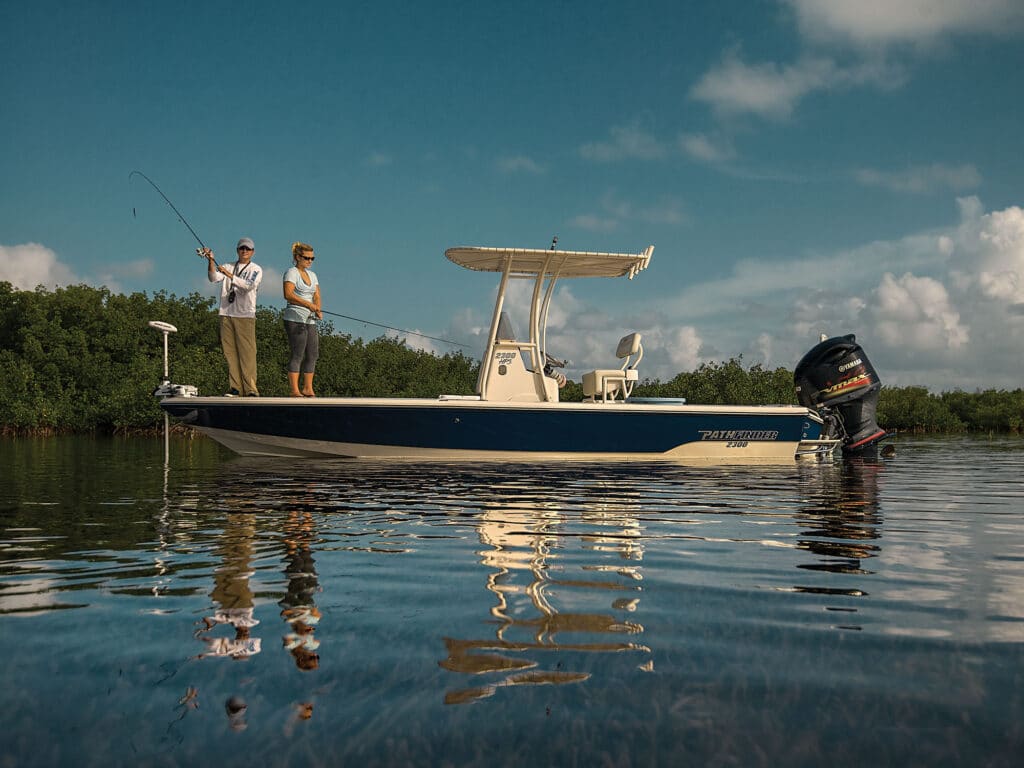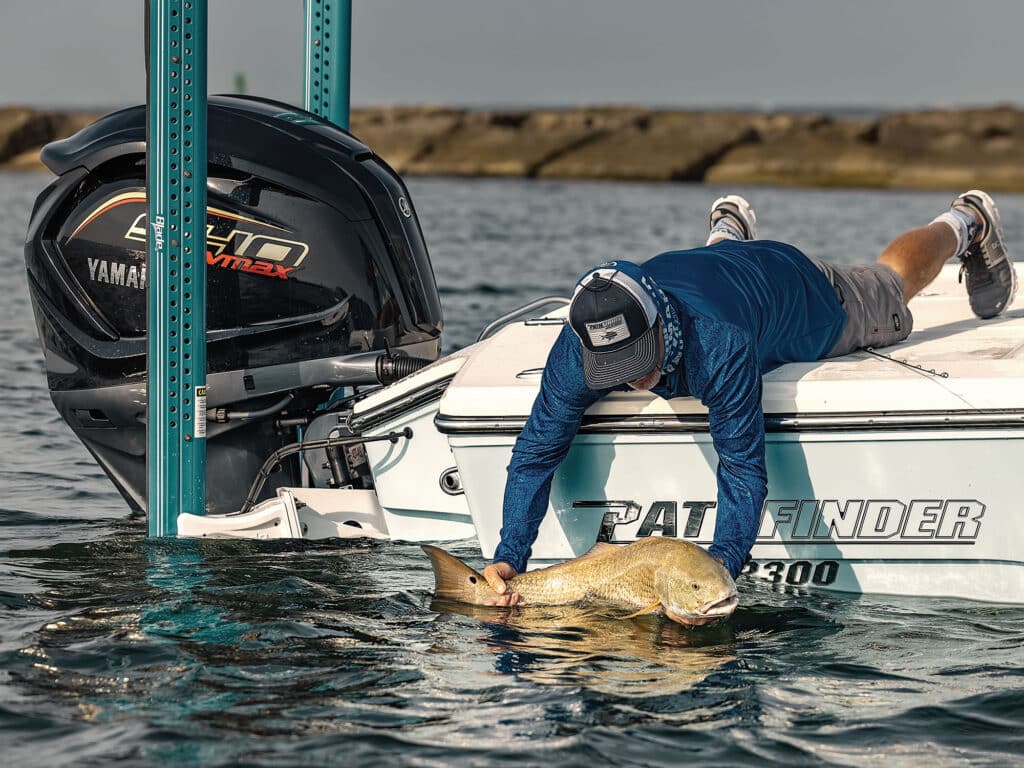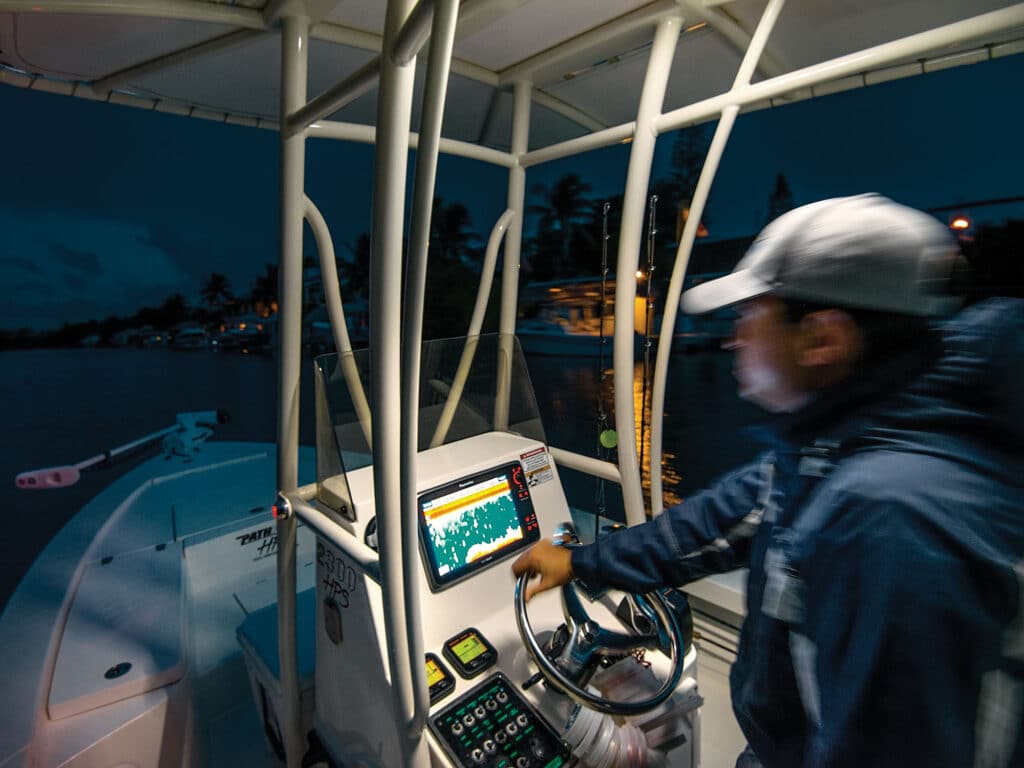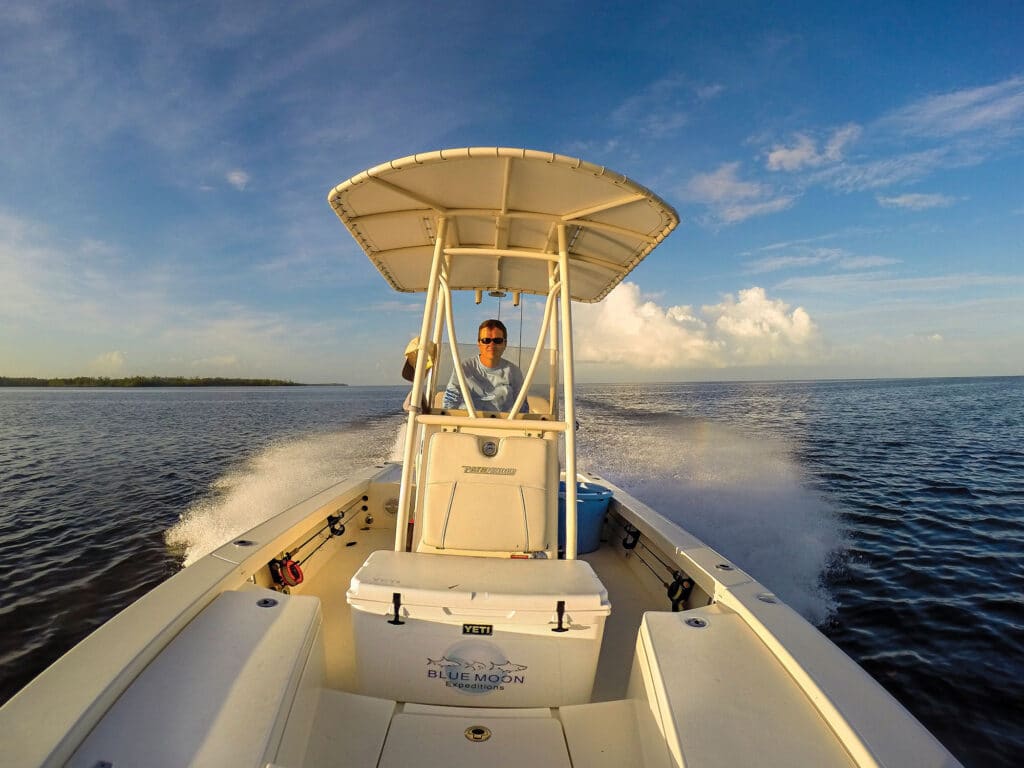Pathfinder 2300 HPS
 The Pathfinder 2300 HPS is available with a GPS-guided trolling motor for precise positioning.
Courtesy Pathfinder Boats
Visit Pathfinder
Build Your Pathfinder
Find a Pathfinder Dealer
The Pathfinder 2300 HPS is available with a GPS-guided trolling motor for precise positioning.
Courtesy Pathfinder Boats
Visit Pathfinder
Build Your Pathfinder
Find a Pathfinder Dealer
You can always tell when a boat is designed by people who actually fish, and the Pathfinder 2300 HPS leaves no doubt that its builders know what works from firsthand experience. Since its introduction, this model has undergone a steady evolution of tweaks to reach the state of perfection for shallow-water fishing it is today. But it still has the size and capability to dash offshore on clement days to the nearest weed line for some mahi madness.
One of the things that jumps out about the Pathfinder 2300 HPS is how few options are needed to go fishing. It offers as standard equipment nearly everything an angler needs to head off into the backcountry to fish. The options list is there merely to customize your boat to fit your particular style of fishing. Its standard live baitwell is set into the rear casting deck and positioned on the centerline for better balance. It holds 35 gallons, which is about the same capacity as the one on a 40-foot Pursuit S378. Not enough? Owners can add another 25-gallon aquarium livewell behind the leaning post for just $794, which puts the boat’s total 60-gallon capacity into rarified air, and that’s not even counting the portside rear compartment that can be repurposed as a release well for holding newly caught fish.
For those who want to run skinny, Pathfinder has you covered with a standard 6-inch Atlas jack plate that has a turn-signal-style control stalk to the left of the Edson wheel, which on our boat was upgraded to one with a powder-coated black finish and spinner knob. The jack plate allows it to run in 15 inches of water without tagging the bottom.
 An integral outboard bracket eliminates the need for a splashwell on the stern of the Pathfinder 2300 HPS to maximize space on the aft casting deck.
Courtesy Pathfinder Boats
An integral outboard bracket eliminates the need for a splashwell on the stern of the Pathfinder 2300 HPS to maximize space on the aft casting deck.
Courtesy Pathfinder Boats
Eight vertical rod holders sit sidesaddle on the center console, and there are three more holders behind the standard leaning post with an Engel cooler underneath. Four more rod holders reside in the gunwales. Twin lockable rod lockers are placed on the outer edges of the large forward casting deck, with two pairs of hinged holders that fold flat when not holding rods. They can fit up to 9-foot-6-inch fly rods. A huge centerline locker has a wide 28-inch opening for storing bulky items like life jackets. The wide step up to the foredeck has a surprisingly deep compartment that can hold an 8-gallon bucket.
Our test boat had a 36-volt Garmin Force Kraken trolling motor ($4,897), which puts out 100 pounds of thrust. Most anglers will equip the 2300 HPS with single or twin 8- or 10-foot Power-Poles for quick, shallow-water anchoring. The dash has enough real estate to handle a 16-inch Garmin touchscreen display, but our boat had a 12-inch Garmin that worked well.
The removable windshield was surprisingly effective. Toggle switches for the accessories are presented in a vertical row for ease of use. Pathfinder also offers the option to add an upper station and even outriggers to boost its offshore capabilities.
 The dash of the center console provides enough room to flush-mount a Garmin 16-inch touchscreen display, but our test boat came with a 12-incher.
Courtesy Pathfinder Boats
The dash of the center console provides enough room to flush-mount a Garmin 16-inch touchscreen display, but our test boat came with a 12-incher.
Courtesy Pathfinder Boats
The center console is compact to preserve deck space and has a toe-rail recess, which reduces toe stubbing. It also has a jump seat in front with a tilt-out tackle-storage compartment built into the backrest and a cooler beneath the seat bottom. One recent improvement is the double-stacked doors into the console that give greater access to batteries, the electronics panel and the helm’s wiring array. You’ll find 58 square feet of cockpit space, and gunwale height is 17.5 inches, which inshore anglers prefer. (Pathfinder makes the 2400 Open, in which the gunwale height in the fishing cockpit measures 22 to 25 inches, which would be a better choice if owners fish offshore on a regular basis.) A removable backrest for the rear deck along with a wide seat bottom for two-plus make long runs comfortable.
The High Performance Stepped (HPS) hull is built using Pathfinder’s proprietary Vacuum-Assisted Resin Infusion System (VARIS). It delivers a light, strong hull because it uses only enough resin to saturate the fiberglass thoroughly. This construction technique, along with the step-hull that introduces air underneath to increase lift, results in outstanding performance.
This is the ideal boat for the waters in and around the St. Johns River in Jacksonville, Florida, my home turf. It vaulted to plane in 3.5 seconds, even without using the standard Bennett trim tabs. The 2300 HPS ran level at a steady angle of 2 degrees at all planing speeds and performed best with the jack plate all the way down. Curiously, our test boat had a Mercury Tempest Plus prop. Brett Cannon, owner of Atlantic Coast Marine, one of Pathfinder’s top dealers, who came along for the test, said the boat also performs well with a Rev 4 prop, another Mercury product that he likes for its shallow-water performance. The downside to straying from Yamaha’s offerings is giving up the opportunity to use a prop with Yamaha’s exclusive Shift Dampener System, which softens gear engagement.
Read Next: Pathfinder 2400 TRS
 A pair of handy rod lockers flanking the forward casting deck and its step can accommodate and protect fly rods as long as 9.5 feet.
Courtesy Pathfinder Boats
A pair of handy rod lockers flanking the forward casting deck and its step can accommodate and protect fly rods as long as 9.5 feet.
Courtesy Pathfinder Boats
Pathfinder has two engine options for the 2300 HPS: Yamaha’s F300 or V MAX SHO VF250, which our test boat had. Both motors share the same 4.2L engine block, but there are a few differences. The main one is that the VF250 we tested had hydraulic steering and a mechanical shifter. Nearly all the Yamaha engines I’ve tested in the last few years, like the F300, had the Digital Electric Steering (DES) system, which includes a power steering system built into the engine itself, so there are no hydraulic hoses. Its smooth, effortless steering along with the Digital Electronic Controls make a perfect shift every time. It has spoiled me. In comparison, the hydraulic system at idle and slow speeds felt like I was driving a truck. But once the speed increased, it performed well and turned crisply.
The 2300 HPS is one of the reasons Pathfinder has been a gold standard for bay boats. It’s simply the ideal boat for challenging inshore and coastal waters. I walked away from the test with a severe case of Pathfinder envy.
Specifications Length:23’6″Beam:8’4″Draft:1′Fuel:61 gal.Weight:3,075 lb.Max HP:300Price:$103,109 (w/ Yamaha V MAX SHO VF250) Contact PathfinderPathfinder – Fort Pierce, Florida; pathfinderboats.com
The post Pathfinder 2300 HPS appeared first on Salt Water Sportsman.
- Home
- About Us
- Write For Us / Submit Content
- Advertising And Affiliates
- Feeds And Syndication
- Contact Us
- Login
- Privacy
All Rights Reserved. Copyright , Central Coast Communications, Inc.